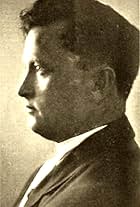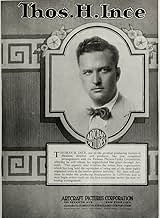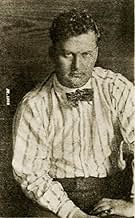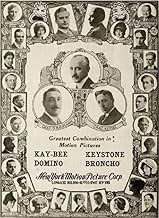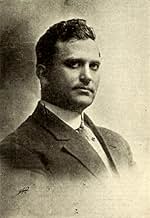Thomas H. Ince(1880-1924)
- Producer
- Additional Crew
- Director
Thomas H. Ince was born into a family of stage actors. He appeared on
the stage at age six and worked with a number of stock companies,
making his Broadway debut at 15. Vaudeville work was inconsistent, so he was a lifeguard, a promoter
and part-time actor. His stage career was a failure but by 1910 he joined Biograph, and after one film,
Carl Laemmle's Independent Motion Pictures hired Ince as a director. Ince went to Cuba to make films out of
the reach of the Motion Pictures Patent Company -- the trust that
attempted to crush all independent production companies and corner the
market on film production -- but his output was small. In 1911 he joined
the New York Motion Picture Corp. [NYMPC] and headed to California to make
Westerns. Ince insisted that all scripts be thoroughly planned out
before filming began, which would give him the opportunity to film
several scenes at the same time with assistant directors. One of those
directors was Francis Ford, the
brother of John Ford.
In 1912, NYMPC and other independent studios merged to form Universal Pictures. Ince built a city of motion picture "sets" on a stretch of land in Santa Monica Mountains called "Inceville" where he shot many of the outdoor locales for his films. At the end of 1912, Ince hired William Desmond Taylor to act in his film Counterfeiters (1914). In 1913 Ince made over 150 films, mostly Westerns and Civil War dramas. He would also employ directors Frank Borzage, Fred Niblo, Jack Conway, and Henry King. In 1914 Ince hired William S. Hart as an actor who could also direct his own films. Ince made the epic The Battle of Gettysburg (1913) and thereafter concentrated on longer films as he moved from director to producer. He employed thousands of technicians and made movies on an assembly-line method. In 1915 he joined D.W. Griffith and Mack Sennett to form the Triangle Motion Picture Company built in Culver City on Washington Boulevard (now the site of Sony Pictures). Fortunately, Hart was a profitable star who kept the company afloat. In 1916 Ince produced and directed the anti-war film Civilization (1915), which cost $100,000 and returned $800.000. Always looking for new talent, Ince signed Olive Thomas, the rising young star of the Ziegfeld Midnight Frolic, to star in his films.
At the end of World War I, Ince broke with Triangle and joined his nemesis Adolph Zukor to form Paramount/Artcraft and built yet another studio in Culver City which had a southern mansion facade of Mount Vernon (and later was bought by David O. Selznick). Ince developed a series of comedies pairing Douglas MacLean and Doris May, and their first picture, 23 1/2 Hours' Leave (1919), was successful. When William S. Hart's contract ended, however, he left the company and Zukor forced Ince out of Paramount/Artcraft. In December 1919 Thomas Ince, Mack Sennett, Marshall Neilan, Maurice Tourneur, Allan Dwan and other directors joined to form Associated Producers, an independent film alliance. 'Roscoe 'Fatty' Arbuckle' had been approached, but he had no desire to join the group. In 1922 Associated Producers merged with First National. On February 1, 1922, Paramount director William Desmond Taylor was shot to death in his bungalow and one of the suspects, although never a serious one, was Mack Sennett, who stated that he spent the night at the home of Ince.
In 1924 Ince was one of several Hollywood people aboard the yacht of newspaper magnate William Randolph Hearst when he suddenly fell ill. Ince was rushed aboard a train bound for Del Mar where his wife, her son, and a physician met him and accompanied him home where he died. The Los Angeles Times supposedly released the headline "Movie producer Shot on Hearst yacht!" but other papers including the New York Times said that Ince died of heart failure. One of the stories that sensationalized Ince's sudden death said that Hearst shot Ince and that the bullet wasn't meant for Ince but for Charles Chaplin, whom Hearst had long suspected of carrying on a secret affair with his mistress, actress Marion Davies. Supposedly, Hearst inadvertently walked into Davies' cabin and caught her and Chaplin in bed together and fired several shots, missing Chaplin but hitting Ince. Another rumor circulated that columnist Louella Parsons was also on board that day and witnessed the shooting, although other sources say Parsons was in New York at the time. Supposedly, in exchange for keeping quiet, Hearst promised Parsons a lifetime job as the Hollywood reporter for his newspaper chain (she was already employed by Hearst in 1923 as a reporter). Ince biographers have disputed the Hearst conspiracy and argued that Ince had been ill for some time with ulcers and had suffered from angina with a previous heart attack.
In 1912, NYMPC and other independent studios merged to form Universal Pictures. Ince built a city of motion picture "sets" on a stretch of land in Santa Monica Mountains called "Inceville" where he shot many of the outdoor locales for his films. At the end of 1912, Ince hired William Desmond Taylor to act in his film Counterfeiters (1914). In 1913 Ince made over 150 films, mostly Westerns and Civil War dramas. He would also employ directors Frank Borzage, Fred Niblo, Jack Conway, and Henry King. In 1914 Ince hired William S. Hart as an actor who could also direct his own films. Ince made the epic The Battle of Gettysburg (1913) and thereafter concentrated on longer films as he moved from director to producer. He employed thousands of technicians and made movies on an assembly-line method. In 1915 he joined D.W. Griffith and Mack Sennett to form the Triangle Motion Picture Company built in Culver City on Washington Boulevard (now the site of Sony Pictures). Fortunately, Hart was a profitable star who kept the company afloat. In 1916 Ince produced and directed the anti-war film Civilization (1915), which cost $100,000 and returned $800.000. Always looking for new talent, Ince signed Olive Thomas, the rising young star of the Ziegfeld Midnight Frolic, to star in his films.
At the end of World War I, Ince broke with Triangle and joined his nemesis Adolph Zukor to form Paramount/Artcraft and built yet another studio in Culver City which had a southern mansion facade of Mount Vernon (and later was bought by David O. Selznick). Ince developed a series of comedies pairing Douglas MacLean and Doris May, and their first picture, 23 1/2 Hours' Leave (1919), was successful. When William S. Hart's contract ended, however, he left the company and Zukor forced Ince out of Paramount/Artcraft. In December 1919 Thomas Ince, Mack Sennett, Marshall Neilan, Maurice Tourneur, Allan Dwan and other directors joined to form Associated Producers, an independent film alliance. 'Roscoe 'Fatty' Arbuckle' had been approached, but he had no desire to join the group. In 1922 Associated Producers merged with First National. On February 1, 1922, Paramount director William Desmond Taylor was shot to death in his bungalow and one of the suspects, although never a serious one, was Mack Sennett, who stated that he spent the night at the home of Ince.
In 1924 Ince was one of several Hollywood people aboard the yacht of newspaper magnate William Randolph Hearst when he suddenly fell ill. Ince was rushed aboard a train bound for Del Mar where his wife, her son, and a physician met him and accompanied him home where he died. The Los Angeles Times supposedly released the headline "Movie producer Shot on Hearst yacht!" but other papers including the New York Times said that Ince died of heart failure. One of the stories that sensationalized Ince's sudden death said that Hearst shot Ince and that the bullet wasn't meant for Ince but for Charles Chaplin, whom Hearst had long suspected of carrying on a secret affair with his mistress, actress Marion Davies. Supposedly, Hearst inadvertently walked into Davies' cabin and caught her and Chaplin in bed together and fired several shots, missing Chaplin but hitting Ince. Another rumor circulated that columnist Louella Parsons was also on board that day and witnessed the shooting, although other sources say Parsons was in New York at the time. Supposedly, in exchange for keeping quiet, Hearst promised Parsons a lifetime job as the Hollywood reporter for his newspaper chain (she was already employed by Hearst in 1923 as a reporter). Ince biographers have disputed the Hearst conspiracy and argued that Ince had been ill for some time with ulcers and had suffered from angina with a previous heart attack.
